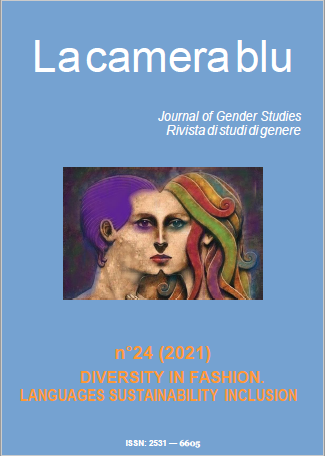Gli abiti di scena gender fluid: l’influenza di Oskar Schlemmer su David Bowie e Lady Gaga
DOI:
https://doi.org/10.6093/1827-9198/8889Parole chiave:
Gender fluid, Lady gaga, Triadisches Ballett, David Bowie, Oskar SchlemmerAbstract
Nel 1922 Oskar Schlemmer portò in scena il Triadisches Ballett, una grande rivoluzione i cui effetti sono visibili ancora oggi. L’artista applicò i principi della scuola d’arte tedesca Bauhaus al mondo teatrale, trasformando il rapporto tra attori ed oggetti posti sulla scena in rapporti geometrici.
Schlemmer spoglia la figura umana delle sue caratteristiche intrinseche, prima fra tutte l’unicità, e la presenta in scena come una maschera costituita da elementi geometrici. Per Schlemmer i protagonisti dell’opera non hanno un sesso definito, gli abiti li trasformano in architetture semoventi. Il corpo non ha genere, è solo un insieme di linee, figure piane e solide. Gli abiti sono realizzati con quelli che Schlemmer definisce «elementi plastici colorati o metallici che si muovono nello spazio, realizzati con materiale che è tanto eccitante usare nel nostro tempo di invenzioni tecniche e di nuove sostanze».
La sperimentazione di Schlemmer era così avanguardistica da colpire anche gli artisti delle epoche successive. Il corpo diventa elemento centrale, «inteso come performance, cioè come costruzione sempre aperta dell’identità materiale»(Calefato, 1996). In più occasioni David Bowie, artista che ha reso il suo stesso corpo un’opera d’arte gender fluid, ha tratto ispirazione dalle opere di Schlemmer. Nel 1974 Bowie apparve nel video di Ziggy Stardust con un costume disegnato da Kansai Yamamoto, che di fatto riproduceva uno dei costumi del Triadisches Ballett. Nel dicembre 1979 Bowie si esibì al Saturday Night Live in un abito estremamente modulare, anch’esso sembrava appena uscito dal balletto di Schlemmer. Si trattava di un outfit con spalle larghe, stretto in vita e assottigliato verso i piedi. L’abito riduceva il corpo del cantante in una forma geometrica esattamente come i protagonisti dell’opera di Schlemmer.
La vivacità della sperimentazione di Schlemmer continua tutt’oggi a colpire l’immaginario degli artisti. Nel 2009 Lady Gaga si affida alla designer Bea Åkerlund per la realizzazione degli abiti da indossare sul set del video Paparazzi. La Åkerlund non viene dal mondo della moda tradizionale, ma da quello del design industriale (ha anche disegnato una collezione per Ikea). La designer decide di creare per Lady Gaga una commistione tra accessori di moda già presentati nelle sfilate di Thierry Mugler, John Galliano, Chanel, Christian Dior e Dolce & Gabbana, ed abiti realizzati appositamente per il video. L’obiettivo della Åkerlund è quello di dare nuova forma al corpo umano, in accordo sia con il pensiero di accettazione del proprio aspetto, di cui Lady Gaga si è sempre fatta portatrice, sia con la narrazione portata avanti dal regista del videoclip Jonas Åkerlund.
Per raggiungere il suo obiettivo, Bea Åkerlund trae ispirazione proprio dalla geometrizzazione del corpo umano proposta dalla sperimentazione di Oskar Schlemmer nel Triadisches Ballett. Situazione analoga nel video di Bad Romance, in cui gli abiti e gli accessori realizzati dal designer Alexander McQueen sembrano snaturare la corporeità di Lady Gaga: non esiste un femminile ed un maschile, ma solo forme.
Downloads
##submission.downloads##
Pubblicato
Come citare
Fascicolo
Sezione
Licenza

Questa opera è distribuita con licenza Creative Commons Attribuzione - Non opere derivate 4.0 Unported.


